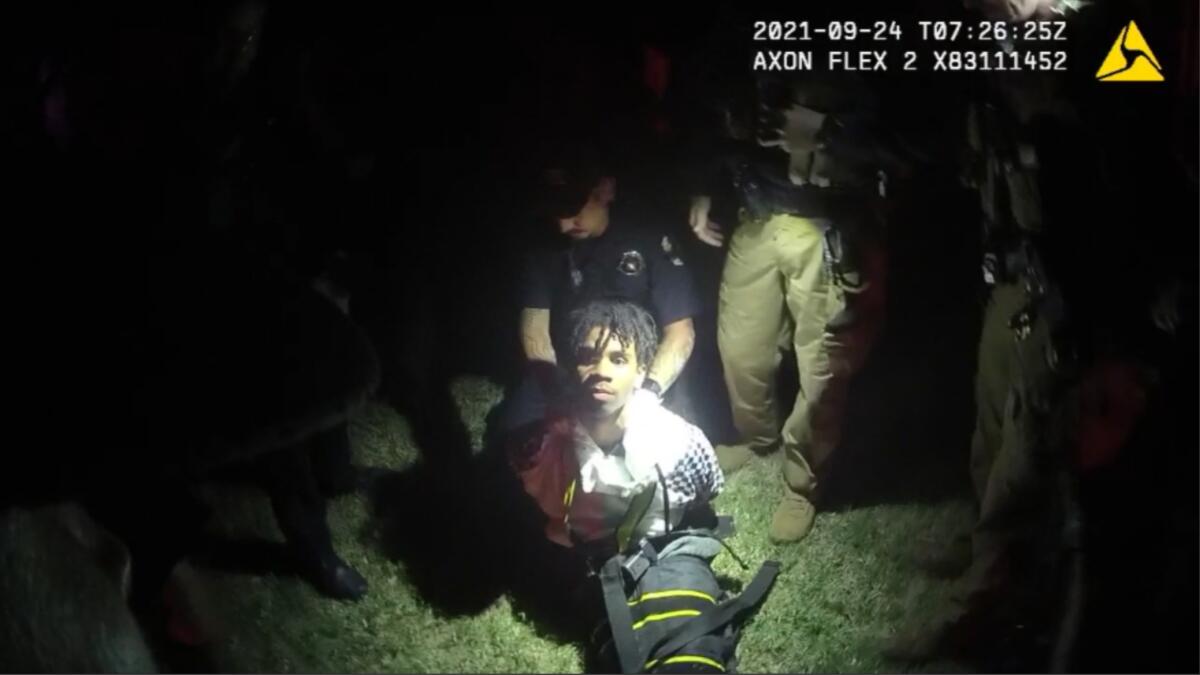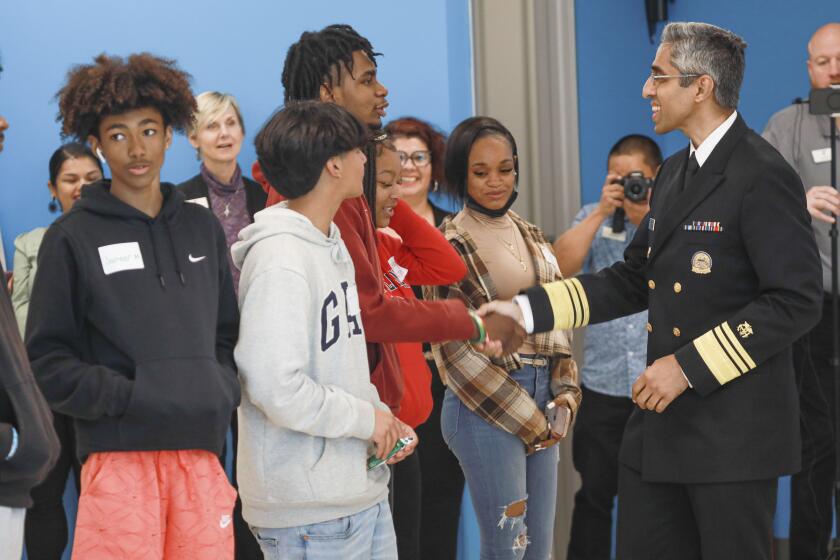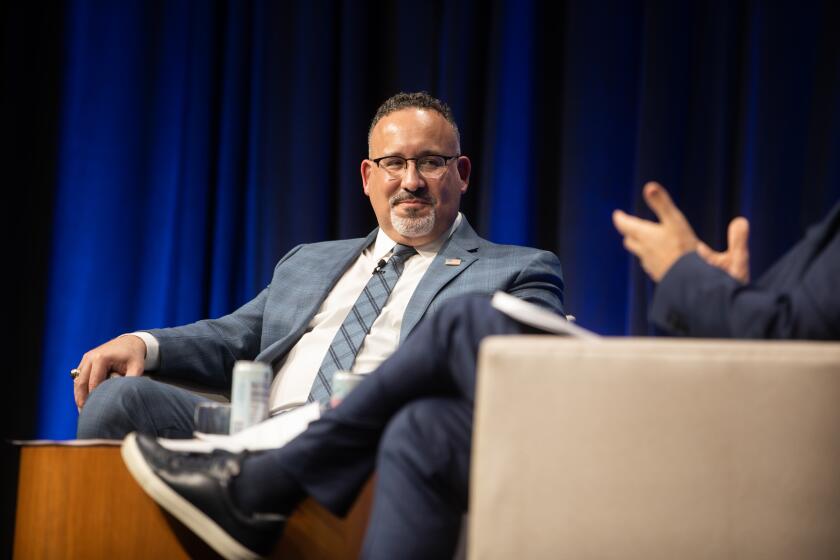‘From crisis to death’: Probing teen’s last, desperate hours

- Share via
MISSION, Kan. — “Y’all here to protect me,” the youth asked the officers, beseechingly. “Right?”
The 17-year-old’s foster father, unable to deal with a teen who seemed to be in the throes of schizophrenia, had called Wichita police. When they arrived, Cedric “C.J.” Lofton refused to leave the porch and go with them; he was obstinate but afraid, meek but frantic.
After an hourlong stalemate, the police lost patience. It was time to take him away — by force, if necessary.
And so began the last two days of a life plagued by family dysfunction, brushes with the law, years in foster care and, finally, mental illness. The events leading to C.J.’s death, just a day short of his 18th birthday, would be captured on video; the result would be litigation, pleas for reform, cries that the system had failed yet another Black youth.
Authorities would decide against any prosecutions in connection with his death. But there were crucial errors, and vital holes in the safety net that had fatal consequences.
Owing to the hour, a team that included a mental health worker was unavailable to respond on that night in September; police alone responded. And C.J. was taken not to a mental hospital but to the county Juvenile Intake and Assessment Center, where for about 40 minutes he was held face down, resulting in his death.
C.J. “went from crisis to death because we got involved,” said Sedgwick County Commissioner Jim Howell.
“We all need to own what we did right and what we did wrong,” he added. “And the reality is there’s things that happened that were wrong.”
___
Friends who met C.J. in foster care described him as a goofball, fun loving, with a dark childhood that he hinted at but never talked about much.
“He would dance everywhere, just wiggly, just you know, no coordination at all. Just dancing just to dance,” said Skylar Mannie, 16, of Wichita.
But under the surface, she sensed anxieties. “He worried about making sure that he was safe, making sure everybody around him was safe and that they were good at all times.”
He was raised with the help of his grandmother. His father, Chadrick Lofton, racked up multiple convictions for domestic assault; one case sent him to prison for a year and a half when C.J. was 2, and after that, C.J. told friends, his father wasn’t around. His mother, Sarah Harrison, also had a criminal record, including a theft conviction in Texas that carried a 400-day sentence.
As he entered his teen years, C.J. was living with his mother in Junction City, a Kansas town of about 22,000 near the Ft. Riley military base. In the summer of 2018, at age 14, he began to get in trouble.
He was accused first of using a stolen debit card, then of stealing a car and tools, court records show. At a football game that fall, he was caught with a BB gun and suspended from school; he was truant often, the court filings show.
Then, in November, he was accused of battery and stealing a video game from a Walmart and was sent to a juvenile detention facility. Court records noted that his “behavior is escalating and there is no parental control,” but he was released to his mother that December.
He broke curfew again and again. Ultimately, a judge signed an order removing C.J. from his home, noting there was “no parent/guardian present.” By August 2019, a court filing found that he was doing “very well” in foster care.
Dr. Vivek Murthy met in San Diego with students who discussed their mental health and how the pandemic has affected their lives.
C.J. moved around at first, friends said. But in December 2020, he was placed in Wichita with a foster father that his friend, Marquez Patton, described as “one of the good ones.”
By all accounts, they got along. C.J.’s foster father told investigators that he had been doing fine in school and that there were no major issues until their final weeks together, according to a report by Sedgwick County Dist. Atty. Marc Bennett.
The foster father, whose name hasn’t been released, declined an interview request through DCCCA Inc., a private foster care agency that contracts with the state’s Department of Children and Families.
During the pandemic-disrupted 2020-21 school year, C.J. became a favorite of Traci Kallhoff, a zoology teacher at Wichita Southeast High School. He was always asking questions, sometimes tossing a blanket over his head to liven up virtual instruction.
“Some of those kids, like when they’re kind of like that, you know, like a little ornery, but really just so full of life, they just kind of grab your heart,” she said, adding that they grew so close that he emailed over summer break and hugged her when classes resumed in the fall.
Patton, 22, met C.J. when they worked at the same McDonald’s. He said among other things, the pair bonded over music — C.J. posted his own classic gangster rap on YouTube, full of references to shootings and bloodshed.
Indeed, C.J. had been part of a Junction City gang, friends said. “Gangs are like a family,” Patton said, but C.J. had vowed to leave that behind and “do better.” The lyrics were merely what sold, he told friends.
He started dating Kyanya Hardyway in June 2021. Her family “loved him,” she said, because he was so respectful. They went to the mall, the YMCA and church together.
Eventually, though, he started telling her and other friends that he was hearing things, that the world was going to end soon. It worried her. But she added: “I was just glad that he was just telling me stuff.”
Friends said C.J. planned to remain in foster care until he finished high school. But he was growing restless as he prepared to age out of the system. Two friends had already been forced from the foster placement after getting in trouble, Patton said.
An expert on the history of mental illness says the psychiatric profession must ‘stop pretending that chemistry is the sole and singular way forward.’
Then, in August, his grandmother died in Texas. Cassandra Harrison’s death was a blow.
His foster father said when Cedric returned from the funeral in September, “it got progressively worse,” according to the prosecutor’s report. He described him as “paranoid.”
Friends saw the difference, too.
“He was really sad. He felt like he didn’t really have anybody,” said Angelee Phillips, an 18-year-old who also had spent time in foster care.
She said she knew he was smoking weed. His foster brothers also suspected he was doing drugs, possibly the synthetic marijuana known as K2, although none had witnessed it firsthand. Partly, their suspicions stemmed from his strange behavior; one foster brother heard C.J. saying that his classmates were robots intent on hurting him.
Tests conducted as part of the autopsy report came up positive for marijuana, nothing else.
By Sept. 22, the situation was escalating. C.J. walked away from school that day and his foster father called police to report him as a runaway.
“He has been telling people not to look in the mirror because it takes your soul,” he told a dispatcher, adding that C.J. thought security guards were secret agents that who were spying on him and that he doesn’t want anyone to come into his room because he says the house is bugged.
Hardyway said he called her around 2 the next morning. She could tell he was outside, but he refused to tell her where.
“He was just telling me like he loved me and stuff and then he just hung up because his phone was about to die,” she recalled. They never spoke again.
___
When C.J. returned home around 11:30 a.m. that Friday morning, the foster father immediately took him to the county’s mental health provider for an evaluation. But they never made it inside.
“He started freaking out and then ran off on me again,” the foster father told police.
He said C.J. had mentioned “he can get access to a gun.” He suspected the teen had schizophrenia. Although C.J. hadn’t been diagnosed, a cousin had told the foster father that the condition ran in the family.
It was all too much. The foster father told a caseworker he couldn’t handle C.J. anymore.
C.J. didn’t realize that when he returned around 1 a.m. on Sept. 24. His foster father told C.J. to stay on the porch, that he was worried about him. He called police.
The community operates a program in which a mental health professional, a law enforcement officer and a paramedic respond to emergent mental health crisis. But it operates only from noon to 10 p.m., Tuesdays through Fridays.
That meant the unit was not available when the foster father called, and police had to go instead — one of the first big missteps, said Sedgwick County Commissioner Lacey Cruse: “We’re expecting law enforcement to do way too much.”
Officers approached the house. What followed plays out on body camera video:
While the foster father attempts to reach the after-hours foster care contacts, officers try to persuade C.J. — who was also sick with COVID-19 — to let them take him to a mental hospital.
“Hell no,” C.J. says.
Over and over, for nearly an hour, they beg him to submit. C.J. offers to sleep outside. He points at things he alone sees, things that do not exist.
Miguel Cardona emphasized teacher residency programs, higher teacher pay
C.J., who had told his foster father that he feared police would shoot him, empties his pockets at one point — apparently, to show the officers he is unarmed. Change clatters to the ground.
“We don’t want your stuff,” an officer tells him.
An officer asks him again about the hospital.
“The hospital,” C.J. says. “I thought you was talking about jail.”
The officer responds: “Not jail, just the hospital. ... I promise you we would go there.”
But C.J. will have none of it. At 2:15 a.m., officers call for assistance. The 5-foot-10, 135-pound teenager is still refusing to budge.
The sergeant who responded to the scene would later explain that he wasn’t willing to just leave C.J. alone outside, according to the prosecutor’s report: “We can’t walk away.”
They decide to take C.J. forcibly.
This was another mistake, said Cruse and fellow commissioner Howell. “Where is this impatience coming from?” Howell asked.
In the video, C.J. screams and yells “help” over and over again as officers grab for his arms.
“This is illegal,” C.J. says. “Isn’t it?”
Breathing heavily, the officers order C.J. not to bite, they are there to help.
Eventually the officers restrain him in something called the WRAP, a device comprised of a locking shoulder harness, leg restraints and ankle straps. The sheriff’s office describes it as a way to restrain a person who is out of control so that they don’t hurt themselves or others.
C.J. is frantic. “They are going to kill me,” he screams, biting at the straps.
As the teen is carried to the police cruiser, he can be heard muttering, repeatedly, “Kill yourself.”
___
The destination was no longer the mental hospital. The sergeant later explained that he believed C.J. was too combative to take there, according to the prosecutor’s report.
Instead, the vehicle headed for the juvenile intake center. C.J. was accused of multiple counts of battering law enforcement officers.
“It shocks me how this child is telling you they are seeing things that don’t exist and an alternate decision, aside from taking him to the hospital, was made,” said Brittany Brest, a community psychologist who is overseeing a grant from the National Alliance on Mental Illness to better support Kansas inmates.
Even one of the officers can be heard questioning the change of destination during the drive, arguing that C.J. would fare better at the mental hospital.
“It fixes whatever is wrong with him,” the officer says. The officers C.J. bit, he said, were “putting themselves in positions of being battered” because they were putting their hands in front of his mouth.
A second officer responds, simply, “It is not our call.”
They pull into the juvenile center at 2:44 a.m. and multiple officers carry him inside. C.J. continues repeating “kill yourself” when he was removed from the WRAP restraint around 3:40 a.m. Officers cautiously back out of the holding cell, leaving C.J. alone inside.
A juvenile worker later opened the door to the cell and told C.J. he “won’t be here that long” if he cooperated with being weighed and fingerprinted.
C.J., though, was still agitated. He walked out of his holding cell and tried to grab a computer monitor from the intake counter, the prosecutor’s report said.
Surveillance video from inside the facility shows him resisting attempts to place him back in the cell. At one point, he can be seen punching one of the juvenile detention employees in the head, knocking his glasses to the ground.
The video, which contains no audio, shows detention workers wrestling him into the cell. The camera angle doesn’t offer a clear view of what happened next.
As Mexican singer-songwriter Carla Morrison releases a new album and embarks on a tour, she’s talking openly and honestly about her mental health.
But the prosecutor’s office said staff shackled C.J.‘s ankles around 4:29 a.m. and put him on his stomach on the floor a few minutes later. One worker held C.J.‘s ankles, another his thighs and two others held down his arms.
C.J. struggled, saying he would “hex” staff and that he was Jesus, according to the report.
A worker can be heard calling dispatch: The teen needed to be taken to a hospital for mental evaluation.
Around 5:08 a.m., the workers managed to put C.J. in handcuffs so he would be ready to be transported when police arrived, according to the prosecutor’s report. He remained face down. The workers then heard what sounded like snoring; they assumed he had tired himself out and fallen asleep.
But C.J. was far from fine. The snoring was likely agonal breathing, a common sign of cardiac arrest, explained Dr. Michael Freeman, a forensic epidemiologist who testified in the George Floyd case.
“I think the biggest problem here is that the people who do the restraint don’t understand how dangerous what they’re doing is,” he said.
C.J.’s COVID-19 infection also would “contribute and make it even more dangerous,” said Dr. Victor Weedn, a forensic science professor at George Washington University. Weedn said the problem is that people can’t breathe fast enough or deep enough when they are restrained face down to get rid of carbon dioxide, especially if they are under stress.
But the workers knew none of this, insisting later that they were using restraints that they had been taught. It took them about five minutes longer to notice something was wrong, roll C.J. on his back and start chest compressions, according to the prosecutor’s report.
They called for help. When the emergency crew arrived, he had no pulse. “I have one 17-year-old male post code red coming to you,” a paramedic called in, after the crew managed to restart his heart.
But his condition was grave, his blood pressure just 62 over 24. And two days later, he was dead. He never regained consciousness.
___
The final autopsy, released in December, listed C.J.‘s cause of death as “complications of cardiopulmonary arrest sustained after physical struggle while restrained in the prone position.” The death was declared a homicide.
Andrew M. Stroth, the family’s attorney, said he is preparing a “robust legal filing,” describing what happened as “tragic on so many levels.”
Sedgwick County Corrections Director Glenda Martens also described what happened as “tragic” in a news conference but said that the corrections workers “acted well within the policy and the requirements of that policy” in restraining the teen.
Meanwhile, interim Wichita Police Chief Lem Moore said his department is looking into the actions officers took when booking the teen. The FBI also is investigating, and Kansas’ governor ordered a review of how the foster care system handled the case.
A task force assembled jointly by the city and county reviewed C.J.’s death. Its members, who include a local NAACP official and a 20-year-old youth organizer, recommended a series of changes, including improving training and mental health services.
Bennett, the district attorney, said he struggled with whether an involuntary manslaughter charge was justified, but concluded in January that the state’s “stand-your-ground” law prevented him from pursuing it because staff members were protecting themselves.
Robert Spitzer, author of “Guns Across America: Reconciling Gun Rules and Rights,” said Bennett’s interpretation is a “perfectly logical application” of a law that he described as “deeply problematic.”
Bennett agrees, calling on the Legislature to change the law and raising questions about nearly everyone involved in C.J.’s care, including the juvenile workers and the foster care system.
“This,” he said, “should never have happened.”
More to Read
Sign up for Essential California
The most important California stories and recommendations in your inbox every morning.
You may occasionally receive promotional content from the Los Angeles Times.














